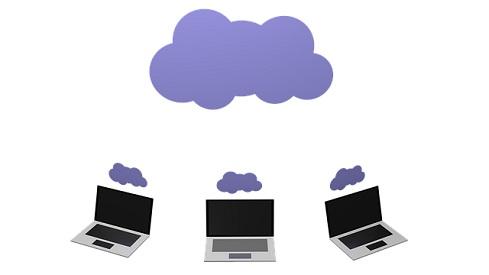3 No-brainer Uses for the Public Cloud
 When comparing cloud architectures, there are a few distinct benefits of public clouds when compared to private and hybrid clouds. First is the fact that as a public cloud customer, you never have to purchase any hardware or software. Your cloud service provider is responsible for all of this — and simply charges you for the services you consume. The other difference is that many public cloud offerings are managed by a service provider all the way up to the application itself. This is known as software as a service (SaaS) — and it can prove cost effective in many enterprise situations.
When comparing cloud architectures, there are a few distinct benefits of public clouds when compared to private and hybrid clouds. First is the fact that as a public cloud customer, you never have to purchase any hardware or software. Your cloud service provider is responsible for all of this — and simply charges you for the services you consume. The other difference is that many public cloud offerings are managed by a service provider all the way up to the application itself. This is known as software as a service (SaaS) — and it can prove cost effective in many enterprise situations.
While many enterprise needs will require the use of a private or hybrid cloud architecture, there are some uses that truly take advantage of the benefits that only the public cloud can deliver. Today, we’re going to look at three examples where we think the public cloud is an absolute no-brainer.
1. Testing and development:
Whenever you are developing and testing out new applications, it is preferable to operate in an environment that not only is not in production, but also in an environment that can rapidly change and adapt to the immediate needs of the dev team. The public cloud can scale, morph and adapt to virtually any situation with a few clicks of a mouse. And when the development project is complete, the entire environment can be either significantly scaled back or even turned off since the public cloud uses a pay-as-you-go pricing model. In 2017, there are very few reasons to be developing in any other environment other than a public cloud.
2. E-mail:
While I think that most will agree that testing and development is an ideal fit for the public cloud, others may not agree that email makes just as much sense. But hear us out on this one. Electronic mail in today’s world is nothing more than a commodity application that can be easily offloaded to an SaaS provider such as Microsoft’s Office 365. Let’s be honest, your company’s internal IT staff are likely not doing anything ground breaking with an on-premise Exchange server. And from a reliability standpoint, you’re going to be hard pressed to beat a global SaaS provider. Your internal staff is also less likely to be able to keep the Office suite as secure as what you would receive from a cloud managed solution. Now, Is it possible to run your email more reliably and securely in-house? Sure, anything is possible. But the added time and money required to adequately operate a local email server these days simply doesn’t make sense.
3. Infrastructure Security:
One of the more recent ways to leverage the public cloud in enterprise-class organizations is to leverage the power of public cloud security services. And even though you can’t move all infrastructure security tools to the public cloud, the tools and services that can be moved are often vastly superior to on premises deployments. For example, cloud-based web and DNS security services have the distinct advantage of being able to protect your end users no matter where they are connecting to the Internet. And considering the fact that today’s enterprises are comprised of an ever-increasing number of mobile users, this is a very good thing. Global threat intelligence and prevention service feeds are another prime example of how public clouds can take security to a whole new level.
Conclusion:
If you sit down and really think about the applications and services that you currently manage in-house — or as part of a private or hybrid-cloud – you may be surprised to find that a public cloud might actually be a better fit. No other cloud architecture can provide the cost savings, scalability and reduction of common IT tasks. So while we’ve listed our top 3 list for no-brainer uses of the public cloud, you’re likely to have many more.
© Source: http://www.informationweek.com/cloud/3-no-brainer-uses-for-the-public-cloud/a/d-id/1327876?_mc=RSS_IWK_EDT
All rights are reserved and belongs to a source media.


 Because of my long-standing association with the Apache Software Foundation , I’m often asked the question, “What’s next for open source technology?” My typical response is variations of “I don’t know” to “the possibilities are endless.”
Because of my long-standing association with the Apache Software Foundation , I’m often asked the question, “What’s next for open source technology?” My typical response is variations of “I don’t know” to “the possibilities are endless.” 
 While the numbers for CES 2017 haven’t been unveiled, it’s probably safe to say that the convention attendance is likely going to eclipse last year’s mark that saw over 100,000 people attend. Now that the crowds have died down and the out-of-towners have gone home, it only seems appropriate that Las Vegas would unveil some tech for the city with its pilot of a self-driving shuttle bus.
While the numbers for CES 2017 haven’t been unveiled, it’s probably safe to say that the convention attendance is likely going to eclipse last year’s mark that saw over 100,000 people attend. Now that the crowds have died down and the out-of-towners have gone home, it only seems appropriate that Las Vegas would unveil some tech for the city with its pilot of a self-driving shuttle bus. 
 Earlier last year at Google’s I/O 2017 developer conference, the company announced the first major update to its Android Wear platform, version 2.0. Developer Previews were set to have five total builds, coming out every six weeks, for a final release in late 2016. Unfortunately, that didn’t end up being the case, as the company ended up delaying the launch until 2017.
Earlier last year at Google’s I/O 2017 developer conference, the company announced the first major update to its Android Wear platform, version 2.0. Developer Previews were set to have five total builds, coming out every six weeks, for a final release in late 2016. Unfortunately, that didn’t end up being the case, as the company ended up delaying the launch until 2017. 
 В адміністрації президента Сполучених Штатів Америки Барака Обами заявили, що його наступник Дональд Трамп спеціально намагається приховати свої фінансові зв’язки з Російською Федерацією.
В адміністрації президента Сполучених Штатів Америки Барака Обами заявили, що його наступник Дональд Трамп спеціально намагається приховати свої фінансові зв’язки з Російською Федерацією. 
 Барселона обіграла Атлетік у повторному матчі 1/8 фіналу Кубка Іспанії з рахунком 3:1 та пробилася у чвертьфінал турніру.
Барселона обіграла Атлетік у повторному матчі 1/8 фіналу Кубка Іспанії з рахунком 3:1 та пробилася у чвертьфінал турніру. 
 Reuters
Reuters 
 Про це у ефірі Еспресо. TV розповів американський журналіст Девід Саттер.
Про це у ефірі Еспресо. TV розповів американський журналіст Девід Саттер. 
 Обраний президент США Дональд Трамп визнав, що Росія влаштувала кібернапади на американські інституції і що за це відповідальний президент Росії Володимир Путін. Про це він заявив на своїй першій прес-конференції як президента 11 січня, повідомляє « Радіо Свобода ».
Обраний президент США Дональд Трамп визнав, що Росія влаштувала кібернапади на американські інституції і що за це відповідальний президент Росії Володимир Путін. Про це він заявив на своїй першій прес-конференції як президента 11 січня, повідомляє « Радіо Свобода ». 
 За словами волонтера Романа Сініцина, учасниками інциденту були бійці розформованої роти МВС “Торнадо”
За словами волонтера Романа Сініцина, учасниками інциденту були бійці розформованої роти МВС “Торнадо” 

